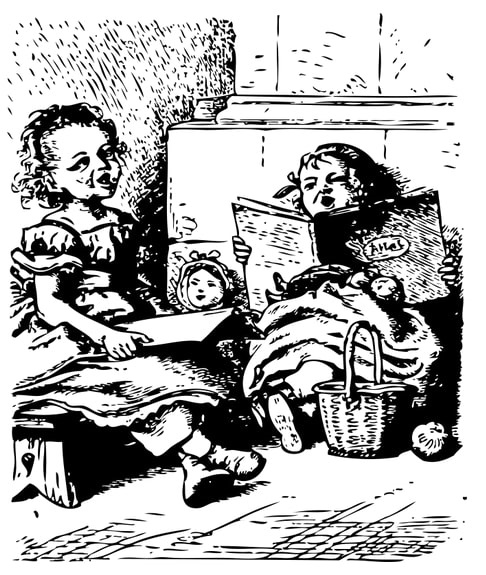Introduction: In this article, Jessica Edwards continues her series exploring the pastimes and toys our ancestors enjoyed when they were children, focusing on games that start with the letter “B,” Part 1. Jessica has had a lifelong interest in her family’s history – especially on her father’s side, which goes back to the first settlers in Pennsylvania, Jamestown and New England – and has documented and added more than 21,000 people to her family tree!
In examining children’s pastimes and toys from 1700 to 1950, we’re looking at a time when children worked more and had less free time than children today. By studying how they played, we can learn about an aspect of our ancestors’ lives not often dealt with in genealogy, and help bring those names and dates on the family tree back to life.

Ball of Wool: Everyone sits around a table with a small ball of wool directly in the center. As the game begins, everyone blows as hard as they can at the ball of wool, trying to prevent it from being blown off their side of the table. If the wool is allowed to fall on someone’s side, that person must pay a penalty by doing one of various bizarre things pre-designated by the group. There was a list of approved and suggested penalties that most people kept to. This was mainly played in the 1800s.
Bandy (also known as “Shinny” or “Curling” or even “Bandy-Wickett”): A game similar to ice hockey, started around 1700 and still played today in the United Kingdom. It really became popular in the 1800s. Organized “Bandy Teams” use a stick shaped much like a modern field hockey stick (except the blade is shorter and more rounded). Some children simply use tree branches for sticks, and everything from a ball of yarn to a tin can for a “ball.” A modern official bandy ball is roughly the size of a tennis ball, with a cork core and hard plastic coating. They are either orange or, more commonly, cerise. The game is played on frozen lakes, ponds, and even rivers (sometimes even indoors). The playing field is called “a sheet’ about 90-110 meters (about 295-360 feet) by 45-65 meters (about 147-213 feet). The goal cage used is about 3.5 meters (11 feet) wide and 2.1 meters (6 feet 11 inches) high. It is the largest goal used by any organized winter team sport.
The earliest origin of the sport is debated, and is claimed by Russia, England, and Holland as each had sports or pastimes which can be seen as forerunners of the present sport. The game’s first published set of rules were codified in 1882 in England by Charles Goodman Tebbutt of the Bury Fen Bandy Club, but records dating back to 1813 reveal that the village of Bury-on-Fen in Cambridgeshire, England, had a bandy team that were unbeaten for a hundred years. It is also thought that Shakespeare was referring to the same game in Romeo and Juliet when he wrote: “The Prince expressly hath forbidden Bandying in the Verona streets.”
Barley-Break: This game was mainly played in the 1500s and 1600s, although occasionally played for several centuries afterward. Jacobean playwrights, incidentally, liked to use “barley-break” as a euphemism for sex. The instructions are fairly simple: three couples (usually of a dating age) are each allotted to one of three squares drawn in a row on the floor. At the word “go,” the couple in the center square – referred to as “prison” or “Hell” – must try and catch one of the other two couples. All three couples must remain holding hands throughout the game, but the two couples being chased can split up and change partners at any time to avoid being caught.
Battledore & Shuttlecock (also known as “Jeu de Volantis”): This is an outdoor game played since the earliest American settlements. Modern badminton and table tennis descend from it. The game is played by two people with small rackets called battledores (which are made of parchment or rows of gut stretched across wooden frames, or sometimes just wooden paddles) and shuttlecocks (made of a base of some light material, like cork, with trimmed feathers fixed around the top). The game is often played while reciting rhymes. The object of the players is to bat the shuttlecock from one to the other as many times as possible without allowing it to fall to the ground. It is believed that games that use shuttlecocks date back to Greece about 2,500 years ago.
Bean Bags: Pioneer kids made their own bean bags out of mom’s scrap material and some dried beans from the garden. To play a simple game, draw a vertical row of squares or circles with some sidewalk chalk, or in the dirt with a stick, and then you attempt to toss the bean bag into a square or circle without the bag touching a line when it lands. Each space is worth a certain amount of points agreed upon by the players. The farther the space is from the tosser, the more points it’s worth.
Being Measured: One child faces the wall of the woodshed or other structure and other students take turns in throwing snowballs at the “target,” trying not to hit but rather come as close as possible to the person against the wall, making a silhouette around them with the shattered snowballs. Whoever misses and hits the target has to take their place, and the former target gets to be one of the ones throwing snowballs.
Up next: Children’s Pastimes and Toys (the Letter ‘B’), Part 2
Related Articles:
